Toujeo
Generic name: insulin glargine
Drug class: Insulin
Medically reviewed by A Ras MD
What is Toujeo?
Toujeo is a long-acting man-made insulin used to control high blood sugar in adults and children who are 6 years of age and older with diabetes mellitus.
Toujeo is not for use to treat diabetic ketoacidosis.
It is not known if Toujeo is safe and effective in children under 6 years of age.
Description
TOUJEO (insulin glargine injection) is a long-acting insulin supplied as a sterile solution for subcutaneous injection containing 300 units/mL of insulin glargine.
Insulin glargine is a human insulin analog produced by recombinant DNA technology utilizing a nonpathogenic laboratory strain of Escherichia coli (K12) as the production organism. Insulin glargine differs from human insulin in that the amino acid asparagine at position A21 is replaced by glycine and two arginines remain at the C-terminus of the B-chain. Chemically, insulin glargine is 21A-Gly-31B-32B-Di-Arg-human insulin and has the empirical formula C267H404N72O78S6 and a molecular weight of 6063. Insulin glargine has the following structural formula:

Each milliliter of TOUJEO contains 300 units (10.91 mg) insulin glargine dissolved in a clear aqueous fluid.
The 1.5 mL TOUJEO SoloStar prefilled pen presentation contains the following inactive ingredients per mL: 90 mcg zinc, 2.7 mg m-cresol, 20 mg glycerol 85%, and water for injection.
The 3 mL TOUJEO Max SoloStar prefilled pen presentation contains the following inactive ingredients per mL: 90 mcg zinc, 2.7 mg m-cresol, 20 mg glycerol 85%, and water for injection.
The pH is adjusted by addition of aqueous solutions of hydrochloric acid and sodium hydroxide. TOUJEO has a pH of approximately 4. At pH 4, insulin glargine is completely soluble. After injection into the subcutaneous tissue, the acidic solution is neutralized, leading to formation of a precipitate from which small amounts of insulin glargine are slowly released.
Mechanism of Action
The primary activity of insulin, including insulin glargine, is regulation of glucose metabolism. Insulin and its analogs lower blood glucose by stimulating peripheral glucose uptake, especially by skeletal muscle and fat, and by inhibiting hepatic glucose production. Insulin inhibits lipolysis and proteolysis and enhances protein synthesis.
What is the most important information I should know about Toujeo?
Do not share your Toujeo SoloStar or Toujeo Max SoloStar pen with other people, even if the needle has been changed. You may give other people a serious infection, or get a serious infection from them.
Who should not use Toujeo?
Do not use Toujeo if you:
- are having an episode of low blood sugar (hypoglycemia).
- have an allergy to insulin glargine or any of the ingredients in Toujeo. See the end of this Patient Information leaflet for a complete list of ingredients in TOUJEO.
What should I tell my healthcare provider before using Toujeo?
Before using Toujeo, tell your healthcare provider about all your medical conditions, including if you:
- have liver or kidney problems.
- take other medicines, especially ones called TZDs (thiazolidinediones).
- have heart failure or other heart problems. If you have heart failure, it may get worse while you take TZDs with TOUJEO.
- are pregnant, planning to become pregnant, or are breastfeeding. It is not known if TOUJEO may harm your unborn or breastfeeding baby.
Tell your healthcare provider about all the medicines you take, including prescription and over-the-counter medicines, vitamins, and herbal supplements.
Before you start using Toujeo, talk to your healthcare provider about low blood sugar and how to manage it.
How should I use Toujeo?
- Toujeo is available in 2 single-patient-use prefilled pens: Toujeo SoloStar and Toujeo Max SoloStar. Your healthcare provider will tell you which Toujeo Pen is right for you.
- Read the detailed Instructions for Use that come with your Toujeo SoloStar or Toujeo Max SoloStar single-patient-use prefilled pen.
- Use Toujeo exactly as your healthcare provider tells you to. Your healthcare provider should tell you how much Toujeo to use and when to use it.
- Know the amount of Toujeo you use. Do not change the amount of Toujeo you use unless your healthcare provider tells you to.
- Check your insulin label each time you give your injection to make sure you are using the correct insulin.
- Do not use a syringe to remove Toujeo from your Toujeo SoloStar or Toujeo Max SoloStar single-patient-use prefilled pen. This can cause you to give yourself too much insulin. Toujeo has 3 times as much insulin in 1 mL compared to other standard insulin pens.
- Do not re-use needles. Always use a new needle for each injection. Reusing needles increases your chance of having blocked needles, which can cause you to get the wrong dose of Toujeo. Using a new needle for each injection also lowers your risk of getting an infection. If your needle is blocked, follow the instructions in Step 3 of the Instructions for Use.
- Toujeo should be used 1 time each day and at the same time each day.
- Toujeo is injected under the skin (subcutaneously) of your upper legs (thighs), upper arms, or stomach area (abdomen).
- Do not use Toujeo in an insulin pump or inject Toujeo into your vein (intravenously).
- Change (rotate) your injection sites within the area you choose with each dose to reduce your risk of getting pits or thickening of the skin (lipodystrophy) and lumps in the skin (localized cutaneous amyloidosis) at the injection sites.
- Do not use the exact same spot for each injection.
- Do not inject where the skin has pits, is thickened, or has lumps.
- Do not inject where the skin is tender, bruised, scaly or hard, or into scars or damaged skin.
- Do not mix Toujeo with any other type of insulin or liquid medicine.
- Check your blood sugar levels. Ask your healthcare provider what your blood sugar should be and when you should check your blood sugar levels.
Keep Toujeo and all medicines out of the reach of children.
Your dose of Toujeo may need to change because of:
- a change in level of physical activity or exercise, weight gain or loss, increased stress, illness, change in diet, or because of other medicines you take.
What should I avoid while taking Toujeo?
While using Toujeo do not:
- drive or operate heavy machinery, until you know how Toujeo affects you.
- drink alcohol or use over-the-counter medicines that contain alcohol.
What are the possible side effects of Toujeo?
Toujeo may cause serious side effects that can lead to death, including:
- low blood sugar (hypoglycemia). Signs and symptoms that may indicate low blood sugar include:
- dizziness or light-headedness, sweating, confusion, headache, blurred vision, slurred speech, shakiness, fast heartbeat, anxiety, irritability or mood change, hunger.
- severe allergic reaction (whole body reaction). Get medical help right away if you have any of these signs or symptoms of a severe allergic reaction:
- a rash over your whole body, trouble breathing, a fast heartbeat, or sweating
- low potassium in your blood (hypokalemia).
- heart failure. Taking certain diabetes pills called TZDs (thiazolidinediones) with Toujeo may cause heart failure in some people. This can happen even if you have never had heart failure or heart problems before. If you already have heart failure it may get worse while you take TZDs with Toujeo. Your healthcare provider should monitor you closely while you are taking TZDs with Toujeo. Tell your healthcare provider if you have any new or worse symptoms of heart failure including:
- shortness of breath, swelling of your ankles or feet, sudden weight gain.
Treatment with TZDs and Toujeo may need to be changed or stopped by your healthcare provider if you have new or worse heart failure.
Get emergency medical help if you have:
- trouble breathing, shortness of breath, fast heartbeat, swelling of your face, tongue, or throat, sweating, extreme drowsiness, dizziness, confusion.
The most common side effects of Toujeo include:
- low blood sugar (hypoglycemia), weight gain, itching, rash, swelling, allergic reactions, including reactions at your injection site, skin thickening or pits at the injection site (lipodystrophy).
These are not all the possible side effects of Toujeo. Call your doctor for medical advice about side effects. You may report side effects to FDA at 1-800-FDA-1088.
How should I store Toujeo?
Toujeo SoloStar Pen
How to store your pen
Before first use
- Keep new pens in the refrigerator between 36°F and 46°F (2°C and 8°C).
- Do not freeze. Throw away your pen if it has been frozen (See “Throwing Away Your Pen”).
After first use
- Keep your pen at room temperature below 86°F (30°C).
- Protect your pen from direct heat and light.
- Do not put your pen back in the refrigerator.
- Do not store your pen with the needle attached.
- Store your pen with the pen cap on.
- Keep Toujeo SoloStar pens and needles out of the reach of children.
How to care for your pen
Handle your pen with care
- Do not drop your pen or knock it against hard surfaces.
- If you think that your pen may be damaged, do not try to fix it. Use a new one.
Protect your pen from dust and dirt
- You can clean the outside of your pen by wiping it with a damp cloth (water only). Do not soak, wash or lubricate your pen. This may damage it.
Toujeo Max SoloStar
How to store your pen
Before first use
- Keep new pens in the refrigerator between 36°F and 46°F (2°C and 8°C).
- Do not freeze. Throw away your pen if it has been frozen (See “Throwing Your Pen Away”).
After first use
- Keep your pen at room temperature below 86°F (30°C).
- Protect your pen from direct heat and light.
- Do not put your pen back in the refrigerator.
- Do not store your pen with the needle attached.
- Store your pen with the pen cap on.
- Keep TOUJEO Max SoloStar pens and needles out of the reach of children.
How to care for your pen
Handle your pen with care
- Do not drop your pen or knock it against hard surfaces.
- If you think that your pen may be damaged, do not try to fix it. Use a new one.
Protect your pen from dust and dirt
- You can clean the outside of your pen by wiping it with a damp cloth (water only). Do not soak, wash or lubricate your pen. This may damage it.
Label
PRINCIPLE DISPLAY PANEL -1.5 ML PEN CARTON
- NDC 0024-5869-03
- Rx ONLY
- Toujeo® SoloStar®
insulin glargine injection - For Single Patient Use Only
- 300 Units/mL (U-300)
- Solution for injection in a disposable insulin delivery device
Do not remove insulin with syringe
Always use a new needle
Do not mix with other insulins
For subcutaneous Injection only
Use only if solution is clear and colorless with no particles visible - Use within 56 days after opening
*Needles not included (see back panel)
Three prefilled pens, 450 units/1.5mL each – Dispense in this sealed carton
SANOFI
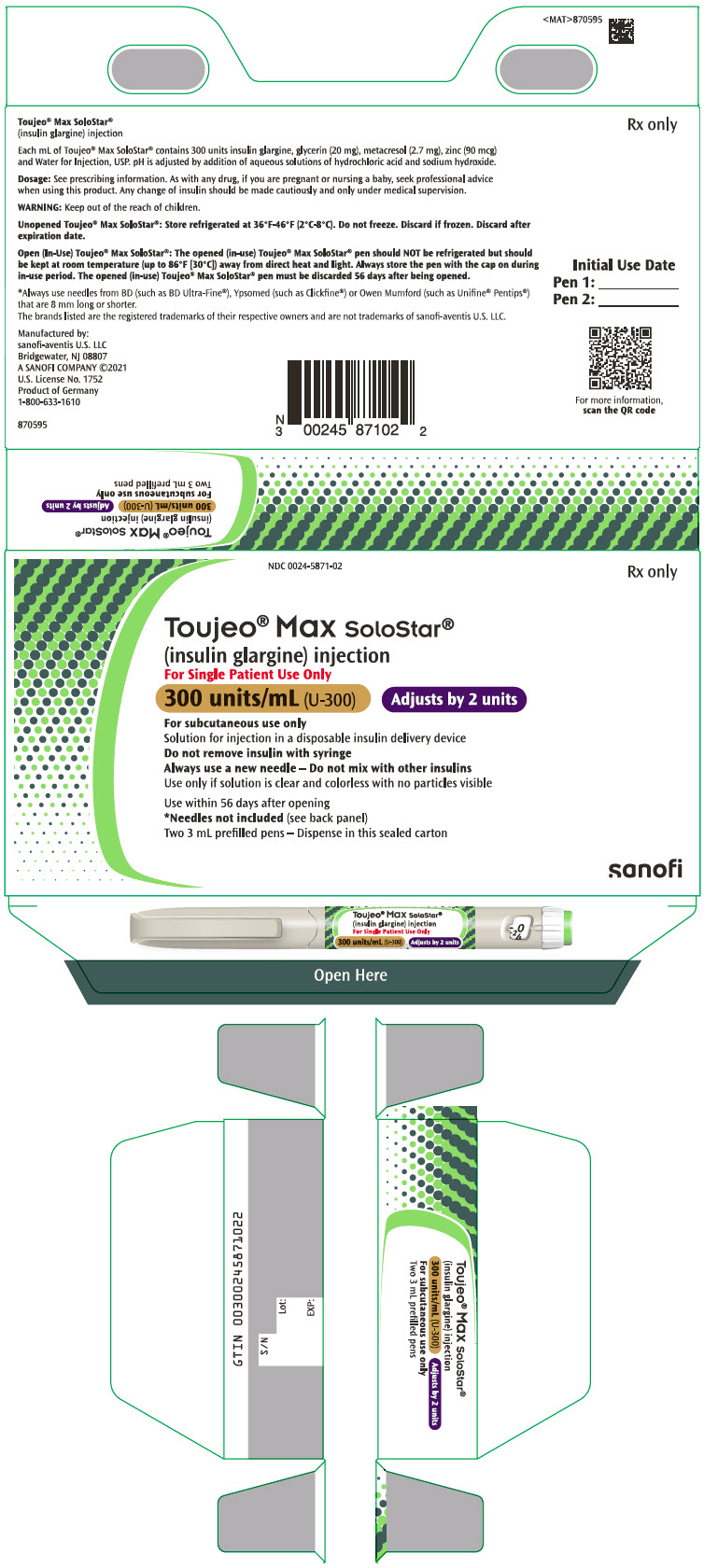
- NDC 0024-5871-02
- Rx ONLY
- Toujeo® Max SoloStar®
insulin glargine injection - For Single Patient Use Only
- 300 Units/mL (U-300)
Adjusts by 2 units - For subcutaneous injection only
Solution for injection in a disposable insulin delivery device
Do not remove insulin with syringe
Always use a new needle
Do not mix with other insulins
Use only if solution is clear and colorless with no particles visible
Use within 56 days after opening
*Needles not included (see back panel)
Two prefilled pens, 900 units/3mL each – Dispense in this sealed carton - SANOFI

What are the ingredients in Toujeo?
Active ingredient: insulin glargine
Inactive ingredients: zinc, m-cresol, glycerol, and water for injection. Hydrochloric acid and sodium hydroxide may be added to adjust the pH.
For more information, go to www.TOUJEO.com or call 1-800-633-1610.
Instructions for use for Toujeo SoloStar
(insulin glargine injection)
1.5 mL single-patient-use prefilled pen
Do not share your Toujeo SoloStar pen with other people, even if the needle has been changed. You may give other people a serious infection, or get a serious infection from them.
Toujeo contains 300 units/mL insulin glargine
- Do not re-use needles. If you do you might not get your dose (underdosing) or get too much (overdosing) as the needle could block.
- Do not use a syringe to remove insulin from your pen. If you do you will get too much insulin. The scale on most syringes is made for non-concentrated insulin only.
- The dose selector of your Toujeo SoloStar pen dials by 1 unit.
People who are blind or have vision problems should not use the Toujeo SoloStar pen without help from a person trained to use the Toujeo SoloStar pen.
Important information
- Do not use your pen if it is damaged or if you are not sure that it is working properly.
- Always perform a safety test (see Step 3).
- Always carry a spare pen and spare needles in case they are lost or stop working.
- Change (rotate) your injection sites within the area you choose for each dose (see “Places to inject”).
Learn to inject
- Talk with your healthcare provider about how to inject, before using your pen.
- Read all of these instructions before using your pen. If you do not follow all of these instructions, you may get too much or too little insulin.
Need help?
If you have any questions about your pen or about diabetes, ask your healthcare provider, go to www.Toujeo.com or call sanofi-aventis at 1-800-633-1610.
Extra items you will need:
- a new sterile needle (not included with the pen) (see Step 2).
- an alcohol swab.
- a puncture-resistant container for used needles and pens (see “Throwing Your Pen Away”).
- Inject your insulin exactly as your healthcare provider has shown you.
- Inject your insulin under the skin (subcutaneously) of your upper legs (thighs), upper arms, or stomach area (abdomen).
- Change (rotate) your injection sites within the area you choose for each dose to reduce your risk of getting pits or thickening of the skin (lipodystrophy) and lumps in the skin (localized cutaneous amyloidosis) at the injection sites.
- Do not inject where the skin has pits, is thickened, or has lumps.
- Do not inject where the skin is tender, bruised, scaly or hard, or into scars or damaged skin.

Get to know your pen

Step 1: Check your pen
Take a new pen out of the refrigerator at least 1 hour before you inject. Cold insulin is more painful to inject.
1A. Check the name and expiration date on the label of your pen.
- Make sure you have the correct insulin.

- Do not use your pen after the expiration date printed on the label.

1B. Pull off the pen cap.

1C. Check that the insulin is clear.
- Do not use the pen if the insulin looks cloudy, colored or contains particles.
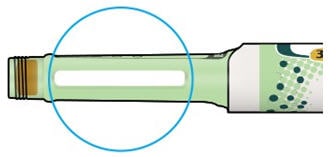
1D. Wipe the rubber seal with an alcohol swab.
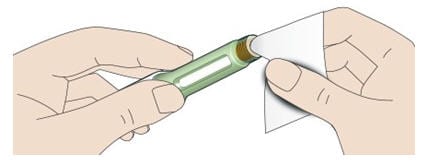
If you have other injector pens
- Making sure you have the correct medicine is especially important if you have other injector pens.
Step 2: Attach a new needle
- Do not re-use needles. Always use a new sterile needle for each injection. This helps stop blocked needles, contamination and infection.
- Always use needles* from BD (such as BD Ultra-Fine), Ypsomed (such as Clickfine), or Owen Mumford (such as Unifine Pentips).
2A. Take a new needle and peel off the protective seal.
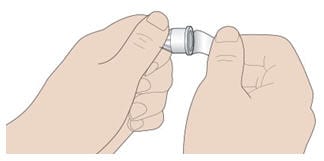
2B. Keep the needle straight and screw it onto the pen until fixed. Do not over-tighten.
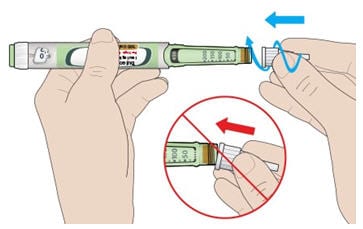
2C. Pull off the outer needle cap. Keep this for later.
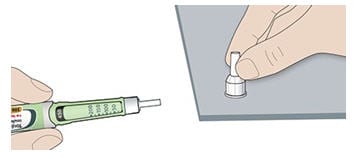
2D. Pull off the inner needle cap and throw away.
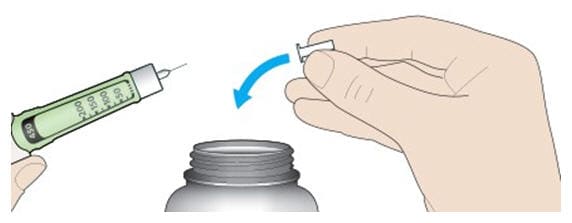
Handling needles
- Be careful when you are handling needles to help prevent accidental needle-stick injury. You may give other people a serious infection, or get a serious infection from them.
Step 3: Do a safety test
Always do a safety test before each injection to:
- check your pen and the needle to make sure they are working properly.
- make sure that you get the correct insulin dose.
If the pen is new, you must perform safety tests before you use the pen for the first time until you see insulin coming out of the needle tip. If you see insulin coming out of the needle tip, the pen is ready to use. If you do not see insulin coming out before taking your dose, you could get an underdose or no insulin at all. This could cause high blood sugar.
3A. Select 3 units by turning the dose selector until the dose pointer is at the mark between 2 and 4.
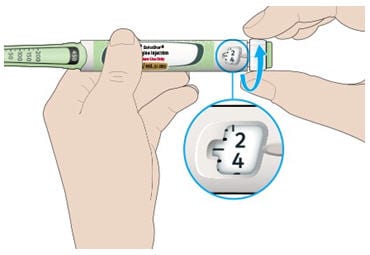
3B. Press the injection button all the way in.
- When insulin comes out of the needle tip, your pen is working correctly.
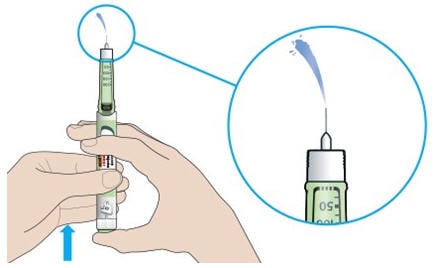
If no insulin appears:
- You may need to repeat this step up to 3 times before seeing insulin.
- If no insulin comes out after the third time, the needle may be blocked. If this happens:
- change the needle (see Step 6 and Step 2),
- then repeat the safety test (see Step 3).
- Do not use your pen if there is still no insulin coming out of the needle tip. Use a new pen.
- Do not use a syringe to remove insulin from your pen.
If you see air bubbles
- You may see air bubbles in the insulin. This is normal, they will not harm you.
Step 4: Select the dose
- Do not select a dose or press the injection button without a needle attached. This may damage your pen.
- Toujeo SoloStar is made to deliver the number of insulin units that your healthcare provider prescribed. You do not need to do any dose calculations.
- The dose selector of your Toujeo SoloStar pen dials by 1 unit.
4A. Make sure a needle is attached and the dose is set to ‘0’.

4B. Turn the dose selector until the dose pointer lines up with your dose.
- Set the dose by turning the dose selector to a line in the dose window. Each line equals 1 unit.
- The dose selector clicks as you turn it.
- Always check the number in the dose window to make sure you dialed the correct dose.
- Do not dial your dose by counting the clicks. You may dial the wrong dose. This may lead to you getting too much insulin or not enough insulin.
- If you turn past your dose, you can turn back down.
- If there are not enough units left in your pen for your dose, the dose selector will stop at the number of units left.
- If you cannot select your full prescribed dose, split the dose into 2 injections or use a new pen. If you use a new pen, perform a safety test (see Step 3).
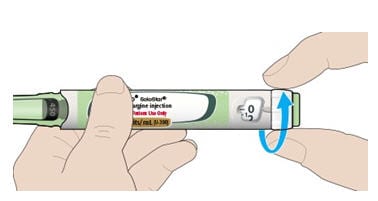
How to read the dose window
The dose selector dials by 1 unit.
Even numbers are shown in line with the dose pointer:
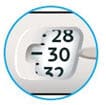
30 units selected
Odd numbers are shown as a line between even numbers:
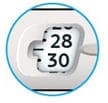
29 units selected
Units of insulin in your pen
- Your pen contains a total of 450 units of insulin. You can select doses from 1 to 80 units. Each pen contains more than 1 dose.
- You can see roughly how many units of insulin are left by looking at where the plunger is on the insulin scale.
Step 5: Inject your dose
If you find it hard to press the injection button in, do not force it as this may break your pen. See the section below for help.
5A. Choose a place to inject as shown in the picture labeled “Places to inject.”
- The site you choose for the injection should be clean and dry.
- If your skin is dirty, clean it as instructed by your healthcare provider.
5B. Push the needle into your skin as shown by your healthcare provider.
- Do not touch the injection button yet.
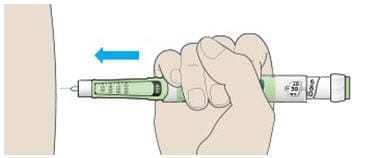
5C. Place your thumb on the injection button. Then press all the way in and hold.
- Do not press at an angle. Your thumb could block the dose selector from turning.
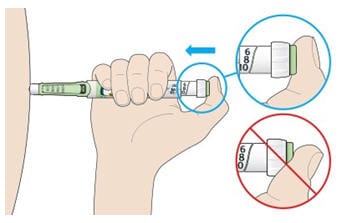
5D. Keep the injection button held in and when you see “0” in the dose window, slowly count to 5.
- This will make sure you get your full dose.
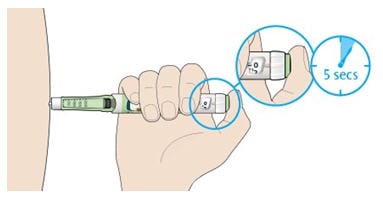
5E. After holding and slowly counting to 5, release the injection button. Then remove the needle from your skin.
If you find it hard to press the button in:
- Change the needle (see Step 6 and Step 2) then do a safety test (see Step 3).
- If you still find it hard to press in, get a new pen.
- Do not use a syringe to remove insulin from your pen.
Step 6: Remove the needle
- Take care when handling needles to prevent needle injury and cross-infection.
- Do not put the inner needle cap back on.
6A. Grip the widest part of the outer needle cap. Keep the needle straight and guide it into the outer needle cap. Then push firmly on.
- The needle can puncture the cap if it is recapped at an angle.
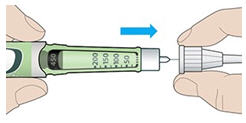
6B. Grip and squeeze the widest part of the outer needle cap. Turn your pen several times with your other hand to remove the needle.
- Try again if the needle does not come off the first time.
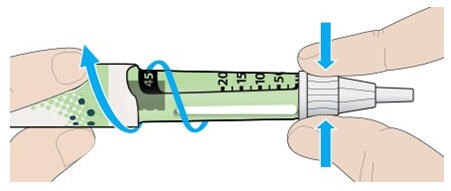
6C. Throw away the used needle in a puncture-resistant container (see “Throwing Your Pen Away” at the end of this Instructions for Use).
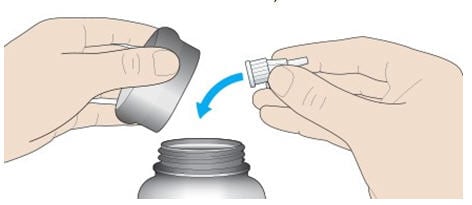
6D. Put the pen cap back on.
- Do not put the pen back in the refrigerator.

Use by
- Only use your pen for up to 56 days after its first use.
How to store your pen
Before first use
- Keep new pens in the refrigerator between 36°F and 46°F (2°C and 8°C).
- Do not freeze. Throw away your pen if it has been frozen (See “Throwing Away Your Pen”).
After first use
- Keep your pen at room temperature below 86°F (30°C).
- Protect your pen from direct heat and light.
- Do not put your pen back in the refrigerator.
- Do not store your pen with the needle attached.
- Store your pen with the pen cap on.
- Keep Toujeo SoloStar pens and needles out of the reach of children.
How to care for your pen
Handle your pen with care
- Do not drop your pen or knock it against hard surfaces.
- If you think that your pen may be damaged, do not try to fix it. Use a new one.
Protect your pen from dust and dirt
- You can clean the outside of your pen by wiping it with a damp cloth (water only). Do not soak, wash or lubricate your pen. This may damage it.
Throwing your pen away
- Put the used Toujeo SoloStar pen in a FDA-cleared sharps disposal container right away after use.
Do not throw away (dispose of) the Toujeo SoloStar pen in your household trash. - If you do not have a FDA-cleared sharps disposal container, you may use a household container that is:
- made of a heavy-duty plastic,
- can be closed with a tight-fitting, puncture-resistant lid, without sharps being able to come out,
- upright and stable during use,
- leak-resistant, and
- properly labeled to warn of hazardous waste inside the container.
- When your sharps disposal container is almost full, you will need to follow your community guidelines for the right way to dispose of your sharps disposal container. There may be state or local laws about how you should throw away used needles and syringes. For more information about safe sharps disposal, and for specific information about sharps disposal in the state that you live in, go to the FDA’s website at: http://www.fda.gov/safesharpsdisposal.
- Do not dispose of your used sharps disposal container in your household trash unless your community guidelines permit this. Do not recycle your used sharps disposal container.
Instructions for use for Toujeo Max SoloStar
(insulin glargine injection)
3 mL single-patient-use prefilled pen
Do not share your Toujeo Max SoloStar pen with other people, even if the needle has been changed. You may give other people a serious infection, or get a serious infection from them.
Toujeo contains 300 units/mL insulin glargine
Do not re-use needles. If you do you might not get your dose (underdosing) or get too much (overdosing) as the needle could block.
Do not use a syringe to remove insulin from your pen. If you do you will get too much insulin. The scale on most syringes is made for non-concentrated insulin only.
The dose selector of your Toujeo Max SoloStar pen dials by 2 units.
People who are blind or have vision problems should not use the Toujeo Max SoloStar pen without help from a person trained to use the Toujeo Max SoloStar pen.
Important information
- Do not use your pen if it is damaged or if you are not sure that it is working properly.
- Always perform a safety test (see Step 3).
- Always carry a spare pen and spare needles in case they are lost or stop working.
- Change (rotate) your injection sites within the area you choose for each dose (see “Places to inject”).
Learn to inject
- Talk with your healthcare provider about how to inject, before using your pen.
- Read all of these instructions before using your pen. If you do not follow all of these instructions, you may get too much or too little insulin.
Need help?
If you have any questions about your pen or about diabetes, ask your healthcare provider, go to www.Toujeo.com or call sanofi-aventis at 1-800-633-1610.
Extra items you will need:
- a new sterile needle (not included with the pen) (see Step 2).
- an alcohol swab.
- a puncture-resistant container for used needles and pens (see “Throwing Away Your Pen”).
Places to inject
- Inject your insulin exactly as your healthcare provider has shown you.
- Inject your insulin under the skin (subcutaneously) of your upper legs (thighs), upper arms, or stomach area (abdomen).
- Change (rotate) your injection sites within the area you choose for each dose to reduce your risk of getting pits or thickening of the skin (lipodystrophy) and lumps in the skin (localized cutaneous amyloidosis) at the injection sites.
- Do not inject where the skin has pits, is thickened, or has lumps.
- Do not inject where the skin is tender, bruised, scaly or hard, or into scars or damaged skin.

Get to know your pen

Step 1: Check your pen
Take a new pen out of the refrigerator at least 1 hour before you inject. Cold insulin is more painful to inject.
1A. Check the name and expiration date on the label of your pen.
- Make sure you have the correct insulin.

- Do not use your pen after the expiration date printed on the label.

1B. Pull off the pen cap.

1C. Check that the insulin is clear.
- Do not use the pen if the insulin looks cloudy, colored or contains particles.
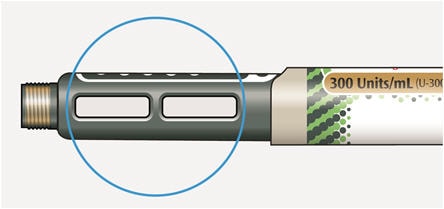
1D. Wipe the rubber seal with an alcohol swab.

If you have other injector pens
- Making sure you have the correct medicine is especially important if you have other injector pens.
Step 2: Attach a new needle
- Do not re-use needles. Always use a new sterile needle for each injection. This helps stop blocked needles, contamination and infection.
- Always use needles from BD (such as BD Ultra-Fine), Ypsomed (such as Clickfine), or Owen Mumford (such as Unifine Pentips) that are 8 mm long or shorter.
2A. Take a new needle and peel off the protective seal.

2B. Keep the needle straight and screw it onto the pen until fixed. Do not over-tighten.
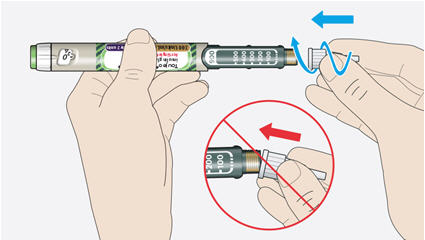
2C. Pull off the outer needle cap. Keep this for later.
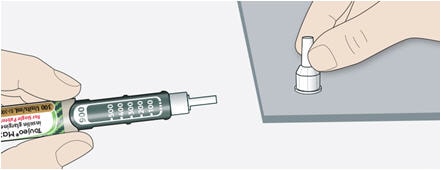
2D. Pull off the inner needle cap and throw away.
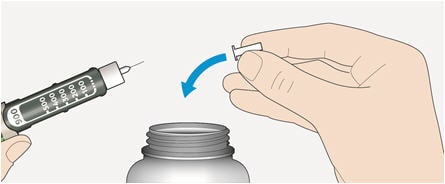
Handling needles
- Be careful when you are handling needles to help prevent accidental needle-stick injury. You may give other people a serious infection, or get a serious infection from them.
Step 3: Do a safety test
Always do a safety test before each injection to:
- check your pen and the needle to make sure they are working properly.
- make sure that you get the correct insulin dose.
If the pen is new, you must perform safety tests before you use the pen for the first time until you see insulin coming out of the needle tip. If you see insulin coming out of the needle tip, the pen is ready to use. If you do not see insulin coming out before taking your dose, you could get an underdose or no insulin at all. This could cause high blood sugar.
3A. Select 4 units by turning the dose selector until the dose pointer is at the 4 mark.
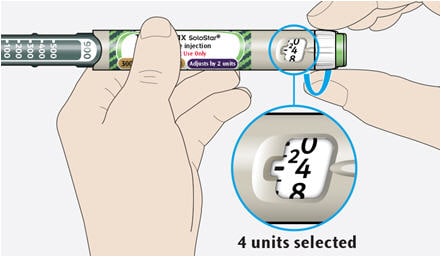
3B. Press the injection button all the way in.
- When insulin comes out of the needle tip, your pen is working correctly.
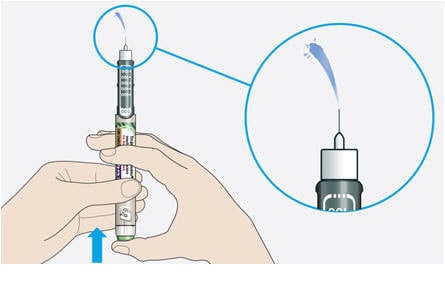
If no insulin appears:
- You may need to repeat this step up to 6 times before seeing insulin.
- If no insulin comes out after the sixth time, the needle may be blocked. If this happens:
- change the needle (see STEP 6 and STEP 2),
- then repeat the safety test (see STEP 3).
- Do not use your pen if there is still no insulin coming out of the needle tip. Use a new pen.
- Do not use a syringe to remove insulin from your pen.
If you see air bubbles
- You may see air bubbles in the insulin. This is normal, they will not harm you.
Step 4: Select the dose
- Do not select a dose or press the injection button without a needle attached. This may damage your pen.
- Toujeo Max SoloStar is made to deliver the number of insulin units that your healthcare provider prescribed. You do not need to do any dose calculations.
- The dose selector of your Toujeo Max SoloStar pen dials by 2 units and can only dial even doses of insulin.
4A. Make sure a needle is attached and the dose is set to ‘0’.

4B. Turn the dose selector until the dose pointer lines up with your dose.
- Set the dose by turning the dose selector to a line in the dose window. Each line equals 2 units.
- The dose selector clicks as you turn it.
- Always check the number in the dose window to make sure you dialed the correct dose.
- Do not dial your dose by counting the clicks. You may dial the wrong dose. This may lead to you getting too much insulin or not enough insulin.
- If you turn past your dose, you can turn back down.
- If there are not enough units left in your pen for your dose, the dose selector will stop at the number of units left.
- If you cannot select your full prescribed dose, split the dose into 2 injections or use a new pen. If you use a new pen, perform a safety test (see Step 3).
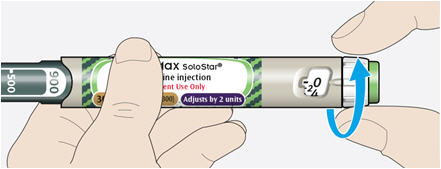
How to read the dose window
The dose selector dials by 2 units.
Each line in the dose window is an even number.
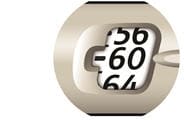
60 units selected
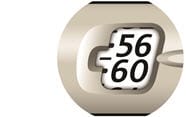
58 units selected
Units of insulin in your pen
- Your pen contains a total of 900 units of insulin. You can select doses from 2 to 160 units. The dose is adjusted by 2 units at a time. Each pen contains more than 1 dose.
- You can see roughly how many units of insulin are left by looking at where the plunger is on the insulin scale.
Step 5: Inject your dose
If you find it hard to press the injection button in, do not force it as this may break your pen. See the section below for help.
5A. Choose a place to inject as shown in the picture labeled “Places to inject.”
- The site you choose for the injection should be clean and dry.
- If your skin is dirty, clean it as instructed by your healthcare provider.
5B. Push the needle into your skin as shown by your healthcare provider.
- Do not touch the injection button yet.

5C. Place your thumb on the injection button. Then press all the way in and hold.
- Do not press at an angle. Your thumb could block the dose selector from turning.
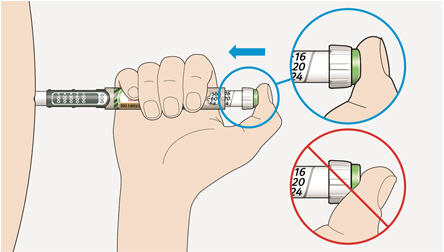
5D. Keep the injection button held in and when you see “0” in the dose window, slowly count to 5.
- This will make sure you get your full dose.
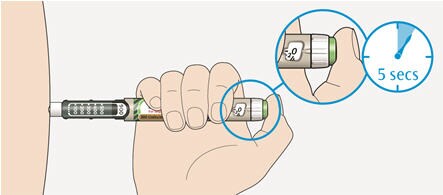
5E. After holding and slowly counting to 5, release the injection button. Then remove the needle from your skin.
If you find it hard to press the injection button in:
- Change the needle (see Step 6 and Step 2) then do a safety test (see Step 3).
- If you still find it hard to press in, get a new pen.
- Do not use a syringe to remove insulin from your pen.
Step 6: Remove the needle
- Take care when handling needles to prevent needle injury and cross-infection.
- Do not put the inner needle cap back on.
6A. Grip the widest part of the outer needle cap. Keep the needle straight and guide it into the outer needle cap.
Then push firmly on.
- The needle can puncture the cap if it is recapped at an angle.
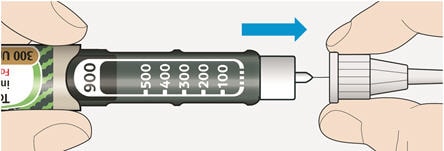
6B. Grip and squeeze the widest part of the outer needle cap. Turn your pen several times with your other hand to remove the needle.
- Try again if the needle does not come off the first time.
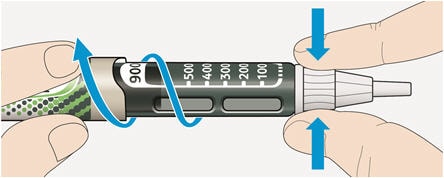
6C. Throw away the used needle in a puncture-resistant container (see “Throwing Your Pen Away” at the end of this Instructions for Use).
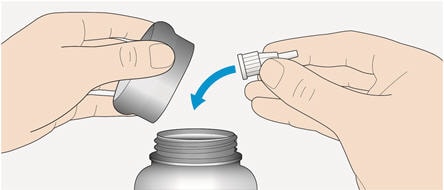
6D. Put the pen cap back on.
- Do not put the pen back in the refrigerator.

Use by
- Only use your pen for up to 56 days after its first use.
How to store your pen
Before first use
- Keep new pens in the refrigerator between 36°F and 46°F (2°C and 8°C).
- Do not freeze. Throw away your pen if it has been frozen (See “Throwing Your Pen Away”).
After first use
- Keep your pen at room temperature below 86°F (30°C).
- Protect your pen from direct heat and light.
- Do not put your pen back in the refrigerator.
- Do not store your pen with the needle attached.
- Store your pen with the pen cap on.
- Keep Toujeo Max SoloStar pens and needles out of the reach of children.
How to care for your pen
Handle your pen with care
- Do not drop your pen or knock it against hard surfaces.
- If you think that your pen may be damaged, do not try to fix it. Use a new one.
Protect your pen from dust and dirt
- You can clean the outside of your pen by wiping it with a damp cloth (water only). Do not soak, wash or lubricate your pen. This may damage it.
Throwing your pen away
- Put the used Toujeo Max SoloStar pen in a FDA-cleared sharps disposal container right away after use. Do not throw away (dispose of) the Toujeo Max SoloStar pen in your household trash.
- If you do not have a FDA-cleared sharps disposal container, you may use a household container that is:
- made of a heavy-duty plastic,
- can be closed with a tight-fitting, puncture-resistant lid, without sharps being able to come out,
- upright and stable during use,
- leak-resistant, and
- properly labeled to warn of hazardous waste inside the container.
- When your sharps disposal container is almost full, you will need to follow your community guidelines for the right way to dispose of your sharps disposal container. There may be state or local laws about how you should throw away used needles and syringes. For more information about safe sharps disposal, and for specific information about sharps disposal in the state that you live in, go to the FDA’s website at: http://www.fda.gov/safesharpsdisposal.
- Do not dispose of your used sharps disposal container in your household trash unless your community guidelines permit this. Do not recycle your used sharps disposal container.
SRC: NLM .
